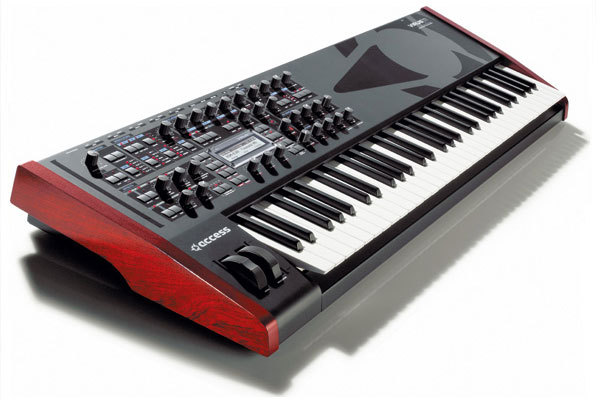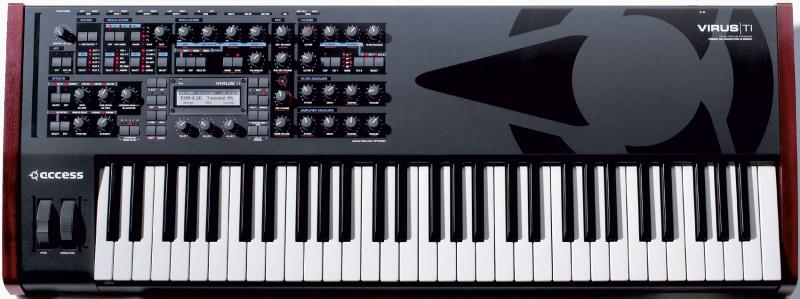Filter on ALL, SYNTH, DRUM, SAMPLER or MISC |
Total list currently 2405 items in 330 Brands |
Access | Virus Ti Kb |
Description | After the Virus C the Virus TI was introduced. The TI includes several oscillator sources from simple sine/tri/saw through to wavetables (63 to choose from, nicely varied; the 64th wavetable is actually the pure sine wave) and also granular and formant sources based on the wavetables. The supersaw mode is present and allows big, spreadable saws with a huge unison effect. If you want it on a digital synth oscillator section, then this has it: 3 oscillators, multiple modes, FM (with several FM applications), oscillator sync, an additional subosc and a noise source. There'll be a bit of menu diving though - the TI may have more physical controls than any Virus before it, but options here outweigh controllers. The menus are logically laid out and fairly simple. The common parameters are on the front panel, and the most in-depth tweaking lies no more than four menu-pages under the hood. There are dual filters with multiple modes from Lowpass, Hipass, Bandpass, Bandreject to more DSP-intensive emulations of analog 1- , 2- and 4-pole modes. These filters are what really make the synth and impart a definite character to the Virus. Most would agree that the Virus sounds dark and ominous rather than the bright, crisp sounds of the Clavias and Korgs. They whine and screech when you crank up the resonance into the self-oscillating regions as well. The Mod Matrix and LFO sections are comprehensive - 18 mod matrix slots, 3 LFO's (which can do double duty as simple third envelopes - although a 3rd envelope feature isn't expressly provided) which can do all the usual LFO tricks. The matrix can even modulate itself; perfect for sonic experiments, but it can be a test remembering just what it is you're trying to modulate. Too many options may not be a valid complaint, but what this synth could really do. The computer integration via USB1 interface doubles as both a DSP audio interface for you computer and enables an onscreen librarian VST3/AU/RTAS plugin interface to appear in your software of choice. If you can do it on the synth, you can do it onscreen, except that some parameters (like arpeggiator settings) can only really be edited on the computer. There's no step sequencer option. The hardware is a metal-skinned, wooden-ended tank, with solid knobs that turn easily yet feel as though they're set in concrete. The desktop version lets you remove the wood, replace with rack ears, and tilt the I/O panel through 90 degrees so you don't lose a rack space above the unit - very clever. Rounding the synth is an effects section, with delays (including tape delays - clocked and free running with modulation and bandwidth options), a reverb (which is used in perhaps a little too many of the 4,000 factory presets as is with many manufacturers) and EQ options with Q control. There's a distortion mode and phaser/chorus/unison effects for thick washes of sounds. The Virus TI Kb has a 61 key keyboard with velocity and aftertouch including the 2 wheels. |
| Brand | Access |
| Model | Virus Ti Kb |
| Device | Synth |
| Type | Keys |
| Engine Type | Digital |
| Engine | VA |
| Voices (max) | 80 |
| Multitimbral | 16 |
| Oscillators | 3 |
| Sub | Y |
| LFO | 3 LFOs, multiple options plus mod matrix 18 slots |
| Noise | Y |
| Engine Detailed | 3 osc + subosc + noise, FM, Sync Waveforms - Sine / pulse / saw / supersaw / wavetable / granular / formant |
| Filter (VCF) | dual LP/HP/BP/BR with envelopes and addtional multi-pole analog emulations (includes Minimoog 4-pole emulation) |
| Envelope (VCA) | Amp / Filter / 'LFO as envelope' option |
| FX | Reverbs, Delays, EQs with Q and freq control, Tape Delays, Distortions (multiple), Phasers, Flangers, Chorus, Analog EQs, Vocoder. |
| Memory | 128 patches in each of 30 banks plus USB storage |
| Keys | 61 |
| Key type | Keys |
| Velocity | Y |
| Aftertouch | Channel |
| Midi | I-O + USB |
| Produced: | 2005 - 2005 |
| Legend: | Obvious | Y: Yes, N: No, N/A: Not Applicable | |
| VCO | Voltage Controlled Oscillator | DCO | Digital Controlled Oscillator |
| LFO | Low Frequency Oscillator | Sub | Sub Oscillator |
| VCF | Voltage Controlled Filter | VCA | Voltage Controlled Amplifier |
| Velocity | As with a piano, the harder you hit a key, the louder the sound, unlike most organs which always produce the same loudness no matter how hard you hit a key. | Aftertouch | Pressing a key after you activated it. Channel Aftertouch, no matter which key, it will send a Channel message. Poly Aftertouch, sends the pressure per key instead of the whole channel. |
| Values for OSC, LFO, Filter, Envelope are per voice unless stated otherwise. | |||




